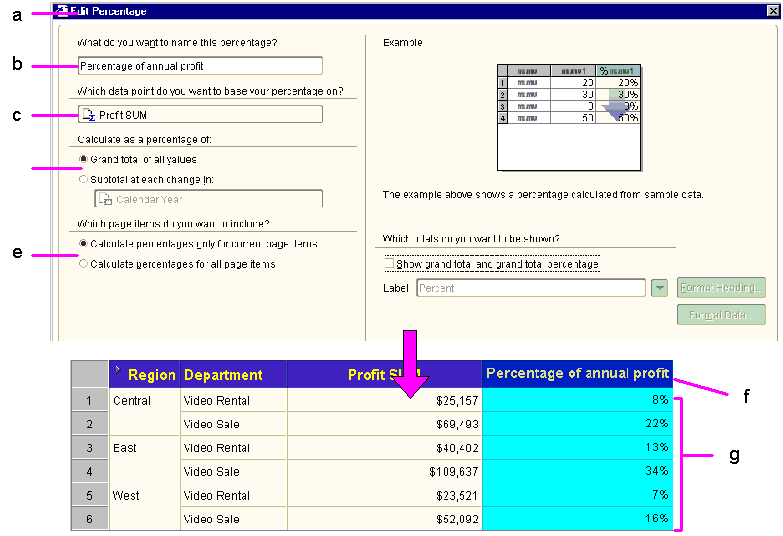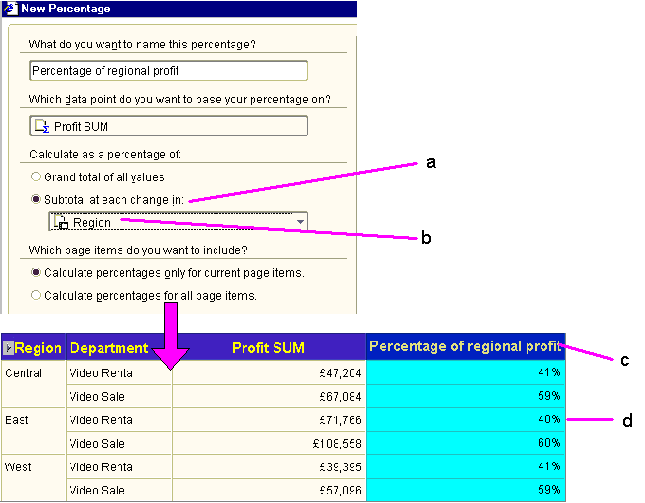Version 9.0.2
Part Number A90879-02
Home | Solution Area | Contents |
Index |
| Oracle9iAS Discoverer Plus User's Guide Version 9.0.2 Part Number A90879-02 |
|
This chapter explains how to use Discoverer percentages to answer typical business questions. For example, what is the sales total for January as a percentage of the annual sales total? This chapter contains the following topics:
Percentages are worksheet items that enable you to quickly and easily calculate percentages of rows and columns. For example, to calculate monthly profit figures as a percentage of the annual profit figure.
The figure below shows a worksheet containing a percentage item called 'Percentage of annual profit'. From this column you can see that the Video Rental department in the Central region contributed 8% of the annual profit total (i.e. $25,157).

If a worksheet contains existing percentages (e.g. percentages created by other Discoverer users, or created by the Discoverer manager) you can display or hide the percentages on the worksheet.
You display or hide the percentages as follows:
To display or hide a percentage:

Text description of the illustration p1.gif
The Percentages tab lists percentages available to the worksheet. The check box beside each item indicates whether it is displayed on the worksheet. Only selected percentages are currently displayed on the worksheet.
For example, choose the Active Only option to display percentages currently displayed on the worksheet.
Hint: To help you decide which percentages to display, use the Description field. The Description field shows any additional information that exists about the currently highlighted percentage.
Discoverer refreshes the worksheet according to the options selected.
You create percentage items to analyze a worksheet in a new way. For example, you might want to display monthly sales figures as a percentage of the annual sales figures.
Worksheets can also contain percentages created by other Discoverer users, or created by the Discoverer manager.
To create a percentage:
Discoverer gives a default name to a new percentage based on what you specify in the "New Percentage dialog".
The drop down list displays numeric items currently displayed on the worksheet. If there is only one numeric item on the worksheet, this item is selected by default.
For example, if the worksheet data is grouped by region, select region here to calculate a percentage sub-total for each region.
The options available depend on whether you have selected the Grand total of all values radio button, or the Subtotal at each change in radio button.
You can also specify a label for the total, and click Format Heading and Format Data to specify how it looks on the worksheet.
Discoverer calculates the percentages and displays them on the worksheet.
You edit percentages to change the way that they behave. For example, you might want to change a grand total percentage to a subtotal and grand total percentage.
To edit a percentage:
Discoverer refreshes the worksheet to reflect changes to the percentage.
You delete a percentage when you no longer want to use it, and want to permanently remove it from a workbook. For example, you might have created a temporary percentage to produce an ad hoc report and now want to remove the percentage from the workbook.
To delete a percentage:
The percentage that you deleted is removed from the list of percentages.
If the deleted percentage was previously displayed on the worksheet, Discoverer removes the percentage information from the worksheet display pane.
Example 1: This example shows how to use the New Percentage dialog to create a new percentage, and how the percentage is displayed on a worksheet. In the figure below, you calculate the profit sum for each region and department as a percentage of total profit.

Key to figure:
Example 2: This example shows how to use the Edit Percentage dialog to produce percentage subtotals. In the figure below, you calculate a subtotal percentage value for each region. In other words, what percentage of profit does each department contribute to the region total.

Key to figure:
|
|
 Copyright © 2002 Oracle Corporation. All Rights Reserved. |
|